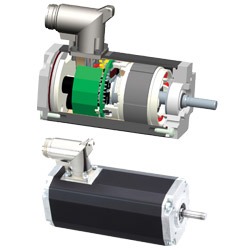 While shortening the iBLDC™ (Intelligent Brushless DC) motors with integral four-quadrant speed controls in the 45-mm frame size by 25 percent, the new size of motor maintains the same power and torque capabilities and motor efficiencies, said the company. The length of the new BG45x15SI was reduced from 120 mm to 88 mm (4.7 to 3.5 inches) and the length of the more powerful BG45x30SI was reduced from 135 mm to 103 mm (5.3 to 4.0 inches). With a 12- or 24-V power source, at a nominal speed of 3,000 rpm, the longer of the two units (BG45x30SI) is continuous duty-rated for 80-W (1/10-hp) power output. Based on the improved design, however, the motors can achieve peak powers of four times the continuous-duty rating, the manufacturer said. The motor target speed can be set using an analog ±10-vdc input signal. Alternatively, different set speeds can be selected via digital inputs using simple start-up software. The drive has a total of four digital inputs. Two inputs are for selecting the four operating conditions: rotation clockwise/counterclockwise, stop with free running, and stop with holding torque. The other two digital inputs are designed for the selection of the fixed motor speed with acceleration and deceleration ramps. In addition, there are three digital outputs with pulse output functions (12 pulses per revolution), the direction of rotation assigned, and fault output signal.
While shortening the iBLDC™ (Intelligent Brushless DC) motors with integral four-quadrant speed controls in the 45-mm frame size by 25 percent, the new size of motor maintains the same power and torque capabilities and motor efficiencies, said the company. The length of the new BG45x15SI was reduced from 120 mm to 88 mm (4.7 to 3.5 inches) and the length of the more powerful BG45x30SI was reduced from 135 mm to 103 mm (5.3 to 4.0 inches). With a 12- or 24-V power source, at a nominal speed of 3,000 rpm, the longer of the two units (BG45x30SI) is continuous duty-rated for 80-W (1/10-hp) power output. Based on the improved design, however, the motors can achieve peak powers of four times the continuous-duty rating, the manufacturer said. The motor target speed can be set using an analog ±10-vdc input signal. Alternatively, different set speeds can be selected via digital inputs using simple start-up software. The drive has a total of four digital inputs. Two inputs are for selecting the four operating conditions: rotation clockwise/counterclockwise, stop with free running, and stop with holding torque. The other two digital inputs are designed for the selection of the fixed motor speed with acceleration and deceleration ramps. In addition, there are three digital outputs with pulse output functions (12 pulses per revolution), the direction of rotation assigned, and fault output signal.
Dunkermotor
www.dunkermotor.com
eProduct 187


Report Abusive Comment